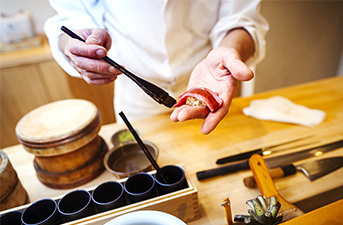Restaurants(15847)
Itamae Yakiniku Ichigyu Kitashinchi
A yakiniku house that more than delivers — tender, silky wagyu sourced from top producers across Japan is sliced at the counter by skilled meat specialists at this sought-after venue in Osaka’s Kitashinchi area.
OffReco Awo
Massive USDA T-bone steaks land on the table, served with an unforgettable Japanese spin, in this artistic hideaway beloved by Toyama’s elite and insiders.
Yakiniku Tsutsui
Located on the fringes of the Kyoto Imperial Palace, the locally owned Yakiniku Tsutsui is one of the city’s few remaining eateries to employ the rare karashi aging technique that traditionally enhances the wagyu’s umami.
Matsuo Jingisukan Sapporo Miyanomori
If you love barbecue, lamb and Hokkaido, Matsuo Jingisukan’s lively Miyanomori branch is the place to be. This iconic name has proudly served Hokkaido-born jingisukan the same way since its opening in 1956.
Matsuo Jingisukan Sapporo Odori Minami 1-jo
Close to Odori Station, the iconic Matsuo Jingisukan branch guarantees that first-time diners will enjoy a delicious jingisukan experience with its signature marinated lamb barbecue.
Ume no Hana Kyoto Karasuma-dori
A tofu specialist restaurant located in the heart of Kyoto’s Karasuma-dori shopping district. Here, tofu is prepared in all manner of different ways, including fried, boiled or even as shumai dumplings.
Ume no Hana Honmachi
Just five minutes from either Shinsaibashi and Hommachi Stations, this tofu specialist restaurant is the perfect place to enjoy the versatility of Japanese beancurd and other luxurious traditional dishes.
Itamae Yakiniku Ichigyu Namba Dotonbori
Live meat slicing at the counter has made this sophisticated yakiniku restaurant in Dotonbori a household name among wagyu enthusiasts.
Bar ODIN
This staunch, basement-level gem is part of Ebisu's new-wave cocktail movement, where inventive concoctions are formulated with organic fruits and some of the world’s rarest spirits.
Yakiniku Ueno Taishoen Main Branch
“Japanese barbecue since 1963,” reads the sign of this long-established yakiniku institution. Its flagship location delivers classic, no-fuss yakiniku, sticking to tradition without overcomplicating things.
Yakiniku Niku no Toriko
Maximizing its three-story space with uniquely themed glamping settings, Yakiniku Niku no Toriko whisks diners away from the hustle of Roppongi to savor Japan’s three great wagyu: Kobe Beef, Matsusaka Beef and Omi Beef.
OffReco Kuro
Hide from the world in this high-design Japanese restaurant in Toyama and sit at its gnarled wood table to embark on a journey through the region’s remarkable terroir — in complete privacy.
Yakiniku 173 (Inami) Mukoyama
A stylish vibe and top-quality meat are the key terms in Yakiniku 173 Mukoyama’s unique fusion of Korean and Japanese dining.
Matsuo Jingisukan Sapporo Kotoni
A cornerstone of Hokkaido’s culinary heritage, Matsuo Jingisukan Sapporo Kotoni branch draws loyal crowds eager to savor its classic dish: Hokkaido-style marinated lamb barbecue, known as jingisukan.
Matsuo Jingisukan Sapporo Susukino 4-2
Since 1956, Matsuo Jingisukan has been serving delicious, tender-grilled lamb and mutton, beloved by Hokkaido locals. Its newest chapter in Sapporo’s Susukino is sleeker and more sophisticated than the rest.
Tonbi Fukushima (Osaka)
Founded 20 years ago, Tonbi Fukushima’s hearty pork degustation features 12 varieties of brand-name pork on any given day, all personally approved by the owner during their travels across Japan.
Unagi Washoku Shirakawa Meieki
Unagi Washoku Shirakawa Meieki is a welcoming unagi restaurant in Nagoya offering Aichi prefecture’s specialty dish, hitsumabashi, just steps from Nagoya Station.
Unagi Kaiseki Nihonbashi Isesada
For three generations, this postwar unagi specialty store in Nihonbashi adheres to the Kanto-style kabayaki method — domestic eels are split along the back to avoid evoking the symbolism of seppuku, then steamed for plumpness.
Minami Aoyama Itoya
Japanese cuisine with a touch of French — Chef Ito’s Minami Aoyama concept honors the essence of washoku while weaving in French influences to deliver the best of both worlds.
Yakiniku Ueno Taishoen Annex
Yakiniku Ueno Taishoen, a yakiniku fixture in Tokyo, continues to preserve the beloved “good old Taishoen flavor” that has captured the hearts of locals since 1963.
Showa Taishu Horumon Main Branch
Step back in time to retro-era Japan through Showa Taishu Horuman’s flagship store, a yakiniku restaurant specializing in deliciously juicy meat with retro, 1950s-inspired interiors.
Showa Taishu Horumon Kyobashi Kita
A good time for a long time. Conversations with friends over charcoal-grilled meats and offal are at their best at Showa Taishu Horumon Kyobashi Kita, a 1950s-inspired retro yakiniku spot that is open until 7 am.
Monja Maguroya Nishinaka
Scoop up a bite of piping hot monjayaki straight from the grill at this legendary, celebrity-magnet monjayaki restaurant visited by Shohei Ohtani.
Maguroya Honten
The main branch of the celebrity-loved monjayaki specialist, Maguroya Honten, earned its status by focusing on what it does best — its irresistible monjayaki and bluefin tuna sashimi.
Tsukiji Sushi Sen Asakusa Kaminarimon
The listing description is what’s seen on byFood’s landing page. Include cuisine, location and main selling points.
Uosaburo
Once the site of a historic battle between samurai and pro-Imperial lords, the 260-year-old Uosaburo continues its founder’s legacy by serving exquisite kaiseki powered by Seto Inland Sea fish, Kyoto heirloom vegetables and Fushimi’s pure well water.
Niku Kappo Akasaka Yuuga
Owner-chef Narita Ryo of this high-end Akasaka "meat kappo" presents a hyper-seasonal menu featuring wagyu, with dishes that change in accordance with the 24 solar terms of the lunar calendar.
OH! TORO KITCHEN Shinbashi
Working alongside Yonekawa Suisan, a Toyosu Market wholesaler with over 85 years of history, OH! TORO KITCHEN Shinbashi in Tokyo serves ultra-fresh tuna with an enviable selection of cuts like cheek meat and heart.
